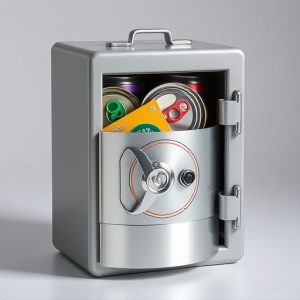Camouflaged Stash Boxes: Creative Disguises for Secret Compartments
The growing trend of stash boxes disguised as common products offers discreet storage solutions for…….
The growing trend of stash boxes disguised as common products offers discreet storage solutions for valuable items, seamlessly blending into everyday environments. These ingeniously designed containers, made from high-quality materials like leather or wood, maintain realism with subtle details like hidden hinges and intricate engravings. Ideal for hiding important documents or jewelry, they cater to those seeking privacy and secrecy. However, the rise of stash boxes camouflaged as products raises legal and ethical questions regarding civil liberties versus public safety, as authorities and innovators navigate evolving technology's implications.
Discover the intriguing world of secret compartments disguised as everyday items, known as stash boxes. These cleverly designed hiding places offer a unique way to secure your belongings discreetly. In this article, we explore the concept, from understanding its history to delving into creative camouflage techniques and design considerations. Learn about various applications, from home security to travel essentials, and navigate legal implications of these innovative storage solutions. Uncover how ordinary products can double as hidden safes for your most prized possessions.
- Understanding the Concept: Unveiling Disguised Stash Boxes
- Creative Camouflage: Everyday Items as Decoys
- Materials and Design Considerations for Secret Compartments
- Applications: Where and How to Hide Your Stash
- Legal and Ethical Implications: Navigating Hidden Storage Solutions
Understanding the Concept: Unveiling Disguised Stash Boxes
In the realm of clandestine storage solutions, the concept of a stash box disguised as a common item has evolved from fiction to reality. These ingeniously designed containers offer a subtle yet effective way to hide valuable items or sensitive materials. By seamlessly integrating with everyday objects, they provide a unique level of discretion, making them ideal for those seeking secure and hidden storage options.
The allure of stash boxes camouflaged as products lies in their ability to blend into various environments without raising suspicion. From books and plant pots to fake electrical devices or even kitchen utensils, these stash boxes can take on countless forms. This versatility makes them a popular choice for individuals looking to safeguard personal belongings, whether it’s important documents, precious jewelry, or other items that require safe-keeping yet discreet access.
Creative Camouflage: Everyday Items as Decoys
In the world of secrecy and stealth, inventors often look to everyday items for inspiration—turning common objects into cunning decoys. This creative camouflage allows for the discreet storage of essential items or even valuable secrets within seemingly innocuous products. By seamlessly integrating a stash box into everyday articles, these innovative designs offer a unique solution for those seeking privacy and security.
Imagine a pen that holds a hidden compartment for vital documents or a book with a secret space to store small treasures. These deceptively simple items serve as the ultimate disguise, making them ideal for both practical purposes and stealthy operations. The art of camouflage takes on a new dimension when everyday products are transformed into reliable hiding places, ensuring that the true purpose remains hidden from curious eyes.
Materials and Design Considerations for Secret Compartments
When designing a secret compartment disguised as a common item, such as a stash box, material selection is paramount. Opting for materials that blend seamlessly with the intended product’s aesthetic is crucial. For instance, using high-quality leather or wood for a faux-book or wallet can provide both functionality and discreetness. These natural materials offer not only a realistic appearance but also a level of durability, ensuring the compartment can withstand regular use while hiding its true purpose.
The design itself should focus on subtle details that enhance realism. Consider incorporating hidden hinges, magnetic closures, or intricate engravings that mimic the item’s supposed functionality. For example, a stash box designed to look like an antique map could feature delicate scrollwork along the edges, adding both charm and deception. Similarly, a book-shaped compartment might include fake pages with subtle textures, making it nearly impossible to discern from an actual literary work.
Applications: Where and How to Hide Your Stash
In today’s world, discretion is key for many individuals who require a secure space to keep their belongings hidden. This is where a stash box disguised as common items comes into play, offering an innovative solution for those seeking privacy and secrecy. These cleverly designed compartments can take various forms, from everyday products like books, plants, or even kitchenware, making them nearly indistinguishable from their regular counterparts.
When it comes to applications, the possibilities are endless. For instance, a small stash box camouflaged as a book could be discreetly placed on a bookshelf, blending in perfectly with your library. Alternatively, a fake rock containing a hidden compartment can be strategically positioned in your garden, providing a natural-looking hiding spot for smaller items. This method is particularly useful for keeping valuables safe while maintaining an aesthetically pleasing environment. Whether you’re traveling and need a secure place to store documents or simply want to keep mementos out of sight, these disguised stash boxes offer a unique and effective way to maintain privacy in various settings.
Legal and Ethical Implications: Navigating Hidden Storage Solutions
The concept of secret compartments disguised as everyday items presents intriguing possibilities but also raises significant legal and ethical concerns. While the idea of a stash box camouflaged as a seemingly innocuous product can offer creative solutions for hiding valuable items or sensitive materials, it blurs the lines between privacy and potential illegal activities. In many jurisdictions, concealing or storing items in a manner to obstruct their lawful discovery is subject to legal scrutiny, particularly if it facilitates criminal behavior.
As technology advances, creating more sophisticated hidden storage options, authorities are also developing methods to detect these secret compartments. This continuous cat-and-mouse game requires careful consideration of civil liberties and privacy rights versus the need for law enforcement to maintain public safety. Ethical implications arise when exploring who should have access to such technology—should it be limited to law enforcement agencies or made readily available, potentially enabling secretive practices?
In conclusion, the concept of integrating secret compartments into everyday items as camouflaged stash boxes offers a unique approach to secure storage. By understanding the principles outlined in this article, from creative camouflage techniques to legal considerations, individuals can explore innovative ways to conceal their belongings safely. Whether for practical or imaginative purposes, these hidden stashes provide an intriguing solution for those seeking discretion and security in today’s world.


